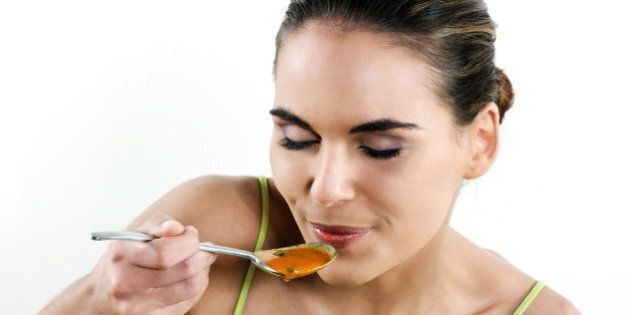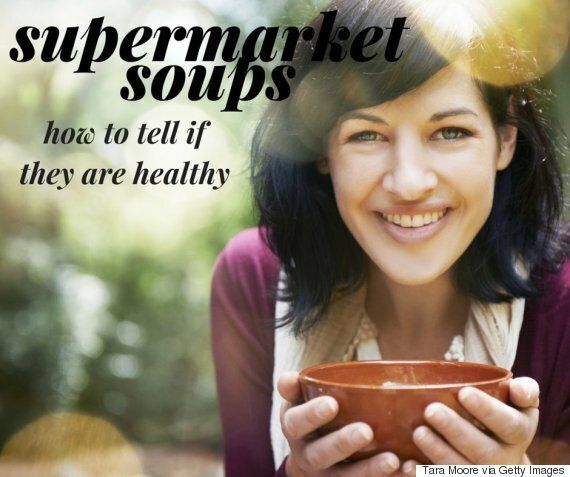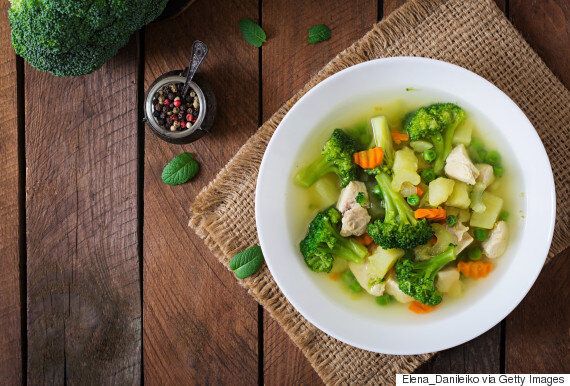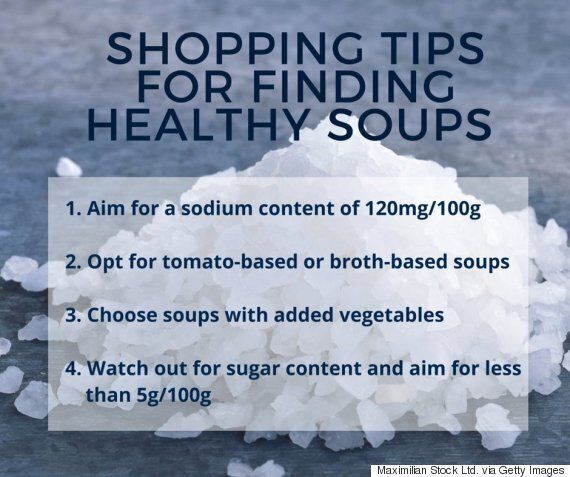

Out of all the not-so-healthy options you could get at the supermarkets, soup probably isn't the first thing that comes to mind. Chocolate and cheesy corn chips, yes -- but soup?
One of the reasons soup can be put in the 'not great' box is due to the salt content, which a lot of the time you don't really notice.
"Salt is used to enhance and improve the taste and flavour of food. It is also used to preserve food -- salt draws out the moisture from food, making it hard for pathogens to grow, thus prolonging the lifespan of food," accredited practising dietitian Sanchia Parker told The Huffington Post Australia.
While we do need some sodium (or salt) in our body to help regulate fluid levels, generally, we get more than enough dietary sodium in our diet without any added salt.
"Our body only needs 200mg of sodium per day, which is about half a gram of salt. However, the average Western diet provides much more than this," Parker said. "More than 75 percent of our sodium intake is from processed and take-away food, with only 25 percent being added at the table."
The National Health and Medical Research Council advises the adequate daily intake of sodium for Australian adults is 460-920mg (around one-third of a teaspoon), and to consume no more than 1,600mg (one teaspoon) of salt a day.
"Eating a diet high in salt increases the amount of sodium in the body. In response, our body retains fluid to restore the sodium level. This causes an increase in blood volume, which requires the heart to work harder to pump the extra fluid, increasing blood pressure," Parker told HuffPost Australia.
"High blood pressure is associated with heart disease, kidney disease and stroke. High blood pressure is also linked to heart failure, kidney stones, oedema and osteoporosis."
While many soups on the supermarket shelves are high in sodium, it is possible to find healthy soup options -- you just have to know what to look for.

"Taking steps to reduce our sodium intake can improve our health and reduce the risk of high blood pressure," Parker said.
"When looking for products we should be aiming for a lower salt intake, which is 120mg per 100 grams. If that’s not possible, then try to avoid anything over 600mg per 100 grams as this is considered a high amount of salt," Parker said.
Just one example of a high salt soup is Country Ladle's Roast Chicken and Winter Vegetables Soup, which contains 612mg of sodium per serving -- practically a whole day's worth of salt for many people.
Aside from checking the sodium content, when shopping for store-bought soups Parker recommends these top tips to ensure you're making a healthy soup choice.
1. Go sans-cream
"Opt for a tomato-based soup or clear broth over a cream-based soup. Not only will the tomato and broth contain fewer calories, but they will be lower in fat," Parker said.
"Plus the tomato-based soups will be a better source of fibre, helping to keep you full."
2. Veg out
"Vegetable or legume-based soups are a good option as you will be able to get a few serves of vegetables in," Parker said.
"Consider adding in vegetables or legumes (think lentils, chickpeas, kidney beans, etc.) to a soup without them to boost the nutrient content, as well as bulk it out."
3. Watch out for sugar
"Some tinned soups can have added sugar, so be sure to check how much sugar is in a tin per 100 grams -- anything less than five grams per 100 grams is a good option," Parker said.

Still unsure of what soups to choose? Try these three recommendations by Parker, as well as three varieties to be more wary of.
Better options
1. Heinz Classic Sweet Potato and Pumpkin Soup
"This soup is low fat, low sugar and lower in salt than other tinned soups, plus it contains two serves of vegetables for a nutrient boost," Parker told HuffPost Australia.
"It is low in protein, though, so bump up the protein content by adding in some chickpeas or lean meat, such as chicken."
2. Macro Organic Vegetable and Lentil Soup
"This is another option that is low fat, low sugar and lower in salt than other soups. It also contains lentils that offer a source of protein."
3. Pitango Chunky Vegetable and Quinoa Soup
"Containing nine different vegetables and whole grains from the quinoa, this soup is a great option," Parker said. "As with the other suggestions, it's low fat, low sugar and lower in salt than other soups."
Not-so-good options
1. Laksa soup
"While it tastes great, the main ingredient in laksa is coconut milk -- an ingredient that is high in saturated fat. Laksa soups can be high in sodium, too," Parker said.
2. Creamy mushroom/pumpkin soup
"Anything with the word 'creamy' in it will have higher amounts of fat (in particular, saturated fat) in it."
3. Tomato soup
"Be sure to check the label of the tomato soup you want, as this flavour is generally higher in sugar than other flavours," Parker said. "Due to the acidity of the tomatoes, adding some sugar cuts through the acidity, making it more palatable.
"Aim for less than five grams of sugar per 100 grams."